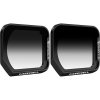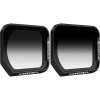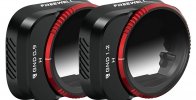- Joined
- Dec 14, 2016
- Messages
- 11
- Reactions
- 4
- Age
- 73
I would think the Mavic 3 Classic GND version should also still work effectively on the Mavic 3 for the main camera lens, without doing much to the telephoto camera. Obviously, one that was designed with separate components for each camera, such as ND filters on each segment that compensate for the difference in the two widest apertures, would be better, with a two stop difference between the top and bottom segments.I'm not sure. Freewell makes one for the Mavic 3 classic, but uncertain about the regular M3. Perhaps you should call B&H photo and see if there are any in the pipeline? I looked on the Freewell site but it appears that gradients are unavailable for the M3's with dual lenses. I would imaging bringing them online would be a matter of seeing how much sales they generate with the Mini 3 and M3C.
Based on my current research no gradients are availble for the regulare Mavic 3, but are available for the M3c. Kind of a wonderment, but no surprise as one would think that every filter manufacturer would be all over these useful tools, WERE THEY TO BE MARKETED CORRECTLY. The different between my PolarPro gradients and standard ND filters is night and day. I have a gradient on my Mavic 2 all the time except for night. Such a difference. The Freewell versions aren't as subtle, but will acomplish a similar look- but not be used quite as universally as I can use the PolarPros. JMO
Here’s the one I bought. It does a pretty good job, especially for the price. There is no GND on the explore camera.Does a graduated or gradient ND filter exist for the Mavic 3? Im using the Cine model

Ok sorry about that, glad you found it. It is obviously a very situational filter but very useful tool to have if you need it.@hagman23 The link you sent came up but it wouldn't add the product to the cart and then it took me back to the home page so I tried again and still didn't work but I did find another place that was offering it.
You can't change dynamic range of the original scene in post. You can make it look better, but blown highlights remain blown, and black shadows will only turn into noise. Lowering the dynamic range of the scene to within the capability of the camera with a GND on the take is the only way to solve the problem of bright skies and dark foregrounds in the same frame on a small sensor.It is far easier to do all of this in post. You can line up with skewed horizontals as well as adjust the darkness as well as the contrast.
Apparently, you've never used one on a drone camera. The horizon does not need to be in the middle while using the GND on a drone camera, and a normal composition of placing the horizon in the upper third of the frame is ideal. I've kept a GND on my Mavic 2 Pro for everything except Spherical Panos, where it unfortunately introduces banding in the stitch. Otherwise, the resulting reduced dynamic range vastly improves both video and stills. Darkened areas at the top of the frame when that is always sky are never a problem. It's much like a vignette which emphasizes the terrain below, and opens upthe shadows. This is the exact opposite of using a PL filter, where everything you have written directly applies.A graduated filter is useless except for straight on horizon shots and then only if you have the camera angle so that the centre fits the view you are filming. This usually means you will have too much sky included in the framing of the shot. In general, you don't have the horizon dead in the middle of the frame, when shooting a landscape image.
A graduated filter is a great asset when you need that top section darkened, but how often do we really need that? Of course, a Graduated filter has its uses. On a still camera on the ground, you can simply take it off and reframe for the shots when you don't need it. However, on a drone, you have to fly back and land, remove it and start flying again. That seems a bit of a bother to me, unless you really need that shot, of course, then it's worth all the hassle.
You definitely can't tilt the camera down, raising the horizon line in the frame, because you'll have too dark of an image at the top part of your frame, when using a graduated filter. Vindibona1 says he keeps one on his Mavic 2 all the time, so I am assuming he never changes his camera angle when out flying, otherwise he would be getting dark areas at the top of his framing the entire time.
Good find! The 7x telephoto camera doesn't really need a GND because the narrow 160mm equivalent FOV doesn't have the same extremes of dynamic range, common to the 24mm 4/3 lens, with bright skies and dark foregrounds in the same frame.Here’s the one I bought. It does a pretty good job, especially for the price. There is no GND on the explore camera.

STARTRC 1 Piece 1110397 GND 8 Filter Adapter Graduated Neutral Density AGC Optical Glass Filter for DJI Mavic 3
Bulk Buy STARTRC 1 Piece 1110397 GND 8 Filter Adapter Graduated Neutral Density AGC Optical Glass Filter for DJI Mavic 3 online at TVC-Mall.com, Shop now for wholesale discounts and fast delivery with the base pricem.tvc-mall.com
Ordered!@hagman23 The link you sent came up but it wouldn't add the product to the cart and then it took me back to the home page so I tried again and still didn't work but I did find another place that was offering it.

Since GND filters I have seen are split in the middle, how does that work when you have a portion of that dark area of the filter protruding into the horizon point and below, into the land? Don't you get a dark strip down into the land portion of your image and then a brighter area of land, where there is no darkened filter part?Apparently, you've never used one on a drone camera. The horizon does not need to be in the middle while using the GND on a drone camera, and a normal composition of placing the horizon in the upper third of the frame is ideal. I've kept a GND on my Mavic 2 Pro for everything except Spherical Panos, where it unfortunately introduces banding in the stitch. Otherwise, the resulting reduced dynamic range vastly improves both video and stills. Darkened areas at the top of the frame when that is always sky are never a problem. It's much like a vignette which emphasizes the terrain below, and opens upthe shadows. This is the exact opposite of using a PL filter, where everything you have written directly applies.
They are not "split" in the middle. They are soft-edged and are blended. Until you have used one, you won't know what you are missing. They are ideal for video and stills to reduce the dynamic range of the scene with an overly bright sky and a much darker foreground subject.Since GND filters I have seen are split in the middle, how does that work when you have a portion of that dark area of the filter protruding into the horizon point and below, into the land? Don't you get a dark strip down into the land portion of your image and then a brighter area of land, where there is no darkened filter part?
Of course, you could always take several photos with varying exposure to solve your problem of bright sky and darkened land mass, then combine as an HDR image.

Ohh I know exactly what they are and they are split in the middle but the graduation begins just above the middle, starting to graduate to clear, and goes clear just below the middle of the split section, in the middle. I've been using such filters in photography since the early 70s. I'm no stranger to photography or filters.They are not "split" in the middle. They are soft-edged and are blended. Until you have used one, you won't know what you are missing. They are ideal for video and stills to reduce the dynamic range of the scene with an overly bright sky and a much darker foreground subject.
Soft-Edge Gradient ND Filters
View attachment 161494
I never worry about it because it is never a problem. The area just below the horizon is lighter than the foreground, so it works perfectly. If you had used one on your drone, you would know this. Analogizing it to other GND uses does not replace real world "drone in the air" usage! Try one, and then report back!Ohh I know exactly what they are and they are split in the middle but the graduation begins just above the middle, starting to graduate to clear, and goes clear just below the middle of the split section, in the middle. I've been using such filters in photography since the early 70s. I'm no stranger to photography or filters.
I know they are graduated, hence the G in the filter name. I have one on my helmet face shield in my aircraft and use it often when I go flying. Mine is graduated on the helmet face shield so it does not obscure my instruments or the runway when I'm on finals during a later evening landing. It's an open cockpit and I have used tinted visors in the past sometimes and if I'm coming home closer to sunset, I can hardly see the runway, so I have to lift the visor in order to see the runway which is not the best thing to do with the wind blast in the eyes. That's the beauty of a graduated visor.
I also know that if you put the horizon in the top third of your frame when filming, you will get the darker section of that graduated tint affecting your horizon, because by the time it is up that high, it is already going dark. You get the graduation if you have the horizon just at or ever so slightly above the middle of the filter.
That is why I was asking what you do about the darker section where the horizon is, in a shot, when you have the horizon set at the top third of your frame, as you stated. Trust me, I know exactly what this filter does and how it affects an image. So, what do you do about that darker section where the land meets the sky when you have the horizon at the top third of your frame, because you will have a darker section there?
If you look at the filters you included photos of, in your post, you can see that a horizon placed at the top third will have the line placed in a darker section of the filter, yet not completely dak, of course. That does affect an image and makes the actual line of the horizon and below, into the ground, a darker affected section that it will be the rest of the way to the bottom of the frame, where it is all clear.
They are not "split" in the middle. They are soft-edged and are blended. Until you have used one, you won't know what you are missing. They are ideal for video and stills to reduce the dynamic range of the scene with an overly bright sky and a much darker foreground subject.
Soft-Edge Gradient ND Filters


This is the one you want. It was $15 yesterday. They have now raised the price to $30! Demand pricing! HAH! Still a good value.View attachment 161506
I want a set for Mavic 3 (standard, not Classic - strange usage of the word "Classic" being that it came out later) I have a pair for Mini 3 Pro. I am not clear on how the numbers are determined other than higher=darker. The Freewell ones for Mini 3 rotate to support portrait/landscape shooting. I wouldn't mind even darker shading, but they seem to want ease of use and reduce failed exposures.
Great for photo work and occasional video as long as you maintain static gimbal pitch. No stitched Panoramas - unless you like stripes!
https://a.co/d/aM5JVHW
View attachment 161507
We use essential cookies to make this site work, and optional cookies to enhance your experience.


